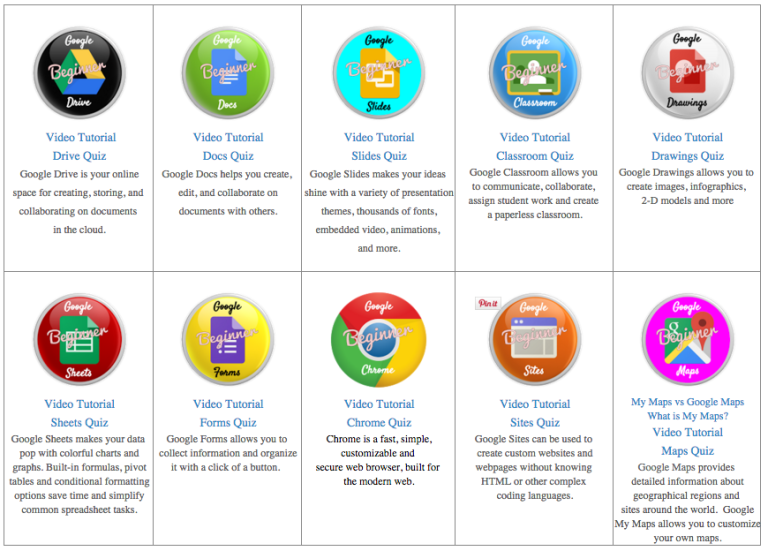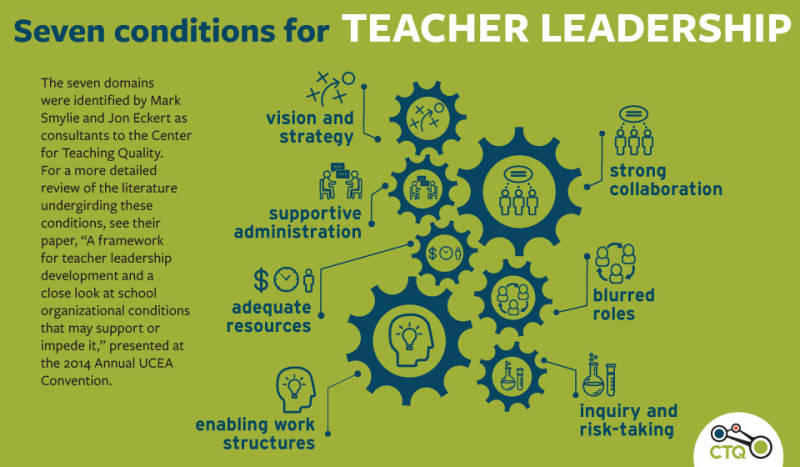Humanities need convincing data to demonstrate their value, says expert
Humanities scholars have always been good at conveying the importance of their work through stories, writes Paula Krebs for Inside Higher Ed, but they have been less successful at using data to do so. This need not be the case, adds Krebs, who recounts a meeting with faculty members, local employers, and public humanities representatives to discuss how to better measure the impact of a humanities education on graduates. Krebs offers a list of recommendations and concrete program changes, such as interviewing employers about their experiences with hiring graduates, that might help humanities programs better prepare students for postgraduate life.
Academica Group <today@academica.ca>
Adding Good Data to Good Stories
https://www.insidehighered.com/views/2016/04/22/importance-developing-hard-data-about-value-humanities-essay
a list of the skills that we think graduates have cultivated in their humanities education:
- Critical thinking
- Communications skills
- Writing skills, with style
- Organizational skills
- Listening skills
- Flexibility
- Creativity
- Cultural competencies, intercultural sensitivity and an understanding of cultural and historical context, including on global topics
- Empathy/emotional intelligence
- Qualitative analysis
- People skills
- Ethical reasoning
- Intellectual curiosity
As part of our list, we also agreed that graduates should have the ability to:
- Meet deadlines
- Construct complex arguments
- Provide attention to detail and nuance (close reading)
- Ask the big questions about meaning, purpose, the human condition
- Communicate in more than one language
- Understand differences in genre (mode of communication)
- Identify and communicate appropriate to each audience
- Be comfortable dealing with gray areas
- Think abstractly beyond an immediate case
- Appreciate differences and conflicting perspectives
- Identify problems as well as solving them
- Read between the lines
- Receive and respond to feedback
Then we asked what we think our graduates should be able to do but perhaps can’t — or not as a result of anything we’ve taught them, anyway. The employers were especially valuable here, highlighting the ability to:
- Use new media, technologies and social media
- Work with the aesthetics of communication, such as design
- Perform a visual presentation and analysis
- Identify, translate and apply skills from course work
- Perform data analysis and quantitative research
- Be comfortable with numbers
- Work well in groups, as leader and as collaborator
- Take risks
- Identify processes and structures
- Write and speak from a variety of rhetorical positions or voices
- Support an argument
- Identify an audience, research it and know how to address it
- Know how to locate one’s own values in relation to a task one has been asked to perform
- Reflect
Technology tools for history lessons
HSTRY Timeline Creator.
HSTRY is a multimedia timeline creation tool that will work on your laptop, Chromebook, iPad, or tablet. With a HSTRY account you can build timelines in a vertical scroll format similar to that of a Facebook feed. To start the process pick a topic and upload a cover photo. To add events to the timeline just click the “+” symbol and select the type of media that you want to add to your timeline. You can add videos, images, audio, and text to the events on your timeline.
There are two features of HSTRY that make it stand-out from the crowd. First, as a teacher you can create an online classroom in which you can view all of your students’ timelines. Second, as a teacher you can build questions into timelines that you share with your students. You can even build-in explanations of the answers to your questions.
For other timeline creation tools, check out this chart.
My note: HSTRY could be a great tool, if the organizers were not that greedy. Their plan + kicks in way to early and does not allow participants to collaborate. E.g., Zaption allows teachers / students to “share” their presentations, but HSTRY asks right away to upgrade. Thumb down!
++++++++++++++++++++++
5 Timeline Creation Tools Compared – Chart
http://www.freetech4teachers.com/2014/12/5-timeline-creation-tools-compared-chart.html
Free Online Tools for Creating Timelines – Richard Byrne – FreeTech4Teachers.com
| |
Multimedia options |
Collaboration options |
Registration required |
iPad/ tablet compatibility |
Output/ publishing |
| Timeline JS
timeline.knightlab.com |
Text Images Videos |
Yes, if you collaborate through Google Spreadsheets*** |
Google Account required. |
Display: yes Creation: no |
Embed code for posting on blog / website. |
| RWT Timeline
bitly.com/1ym46nY |
Text Images |
No. |
No. |
iPad app bitly.com/1vMTI7C Android app bitly.com/1vOcZEB Web app bitly.com/1ym46nY |
PDF.
Image saved on camera roll. |
| TimeGlider*
timeglider.com |
Text Images |
Yes. |
Yes. |
Display: yes Creation: yes |
Embed code for posting on blog / website. Direct link to TG page. |
| Dipity**
dipity.com |
Text Images Videos |
Yes. |
Yes. |
Display: yes Creation: no |
Embed code for posting on blog / website. |
| MyHistro
myhistro.com |
Text Images Videos |
No. |
Yes. |
Display: yes Creation: iOS |
PDF.
Embed code. |
*TimeGlider’s basic plan is free for students. A paid subscription is required to activate collaboration tools.
**Dipity’s basic plan is free for students. The basic account is limited to three timelines.
***Timeline JS utilizes Google Spreadsheets as the basis of timeline event creation. Students collaborate on a spreadsheet to build timelines. A video of the process is available at http://bitly.com/1zRLdr5
++++++++++++++++++++++
More on the use of technology in history in this IMS blog:
https://blog.stcloudstate.edu/ims?s=history
purpose: draft a document for the provost to plan for charting the future goal 3.12 “develop a comprehensive strategy to increase awareness and development of e-textbooks and open educational resources (OERs)”
\\STCLOUDSTATE\HuskyNet\DeptFiles\LRS\ETextbooks
SCSU goal: to reduce the cost of textbooks as an affordable learning initiative. Amount of reduction is undetermined
my notes based on the material below:
- best, most applicable source for the purpose of this research: U of Alberta Committee’s notes on the learning environment:
http://www.governance.ualberta.ca/en/GeneralFacultiesCouncil/CommitteeontheLearningEnvironm/~/media/Governance/Documents/GO05/LEA/15-16/WEB/Item-4-eTextbook-Subcommittee-Report-CLE-TLAT.pdf
the Canadians are using (citing) Acker (Ohio) in their research.
- best, most applicable source in terms of the logistics on e-texbooks creation and its pedagogical argumentation is this document from New Zealand: https://akoaotearoa.ac.nz/download/ng/file/group-7/guidelines-for-developing-interactive-etextbooks-on-net-tablets.pdf
- According to Bossaler et al (2014), it might be worth considering that SCSU (MnSCU?) must go first through implementing of e-text[books] in courses first by using publisher materials and then by using “in-house” produce. At this point, SCSU does NOT have an aligned policy of integrating e-texts in courses across campus. Lack of such experience might make a strategy for adoption of e-textbooks much more complex and difficult to implement
- stats are colored in green for convenience. Stats regarding the increase in textbook costs are re-printed from author to author: e.g. Acker (2011, p. 42). Murey and Perez (2011, p. 49 (bottom) – 50 (up)) reports stats from 2009 and projections for 2013 regarding etexbook adotion. Same authors, p. 50 second paragraph reports good stats regarding texbooks’ price increase : US$1122 per year for textbooks in 2010.
- Wimmer at al (2014) presents a lucid graphic of the structure of the publishing process (see bottom of this blog entry for citation and perm link).
- Wimmer at al (2014) discusses copyright and permissions, which is of interest for this research (p. 85)
- regarding in-house creation of e-textbooks, see (Distance education, e-learning, education and training, 2015). It very much follow the example of SUNY, which Keith was laying out: a team of faculty charged with creation the e-textbook for mass consumption.
Besides the SUNY model Keith is envisioning for MnSCU (comparable), there is the option of clustering OER sources: e.g. NASTA as per Horejsi (2013), CourseSmart. FlatWorld Knowledge (Murrey and Perez, 2011) etc.
- Hamedi & Ezaleila (2015) present an entire etextbook program. Article has been ordered through ILL. Same with Joseph (2015).
- Open Educational Resources in Acker (2015, p. 44-47). Also in Murey and Perez (2011, p. 51).
Also in ICWL (Conference) (13th : 2014 : Tallinn, E., & Cao, Y. (2014): OpenDSA
- Different models of pricing also in Acker (2015, p. 48). Keith touched on that
- students learn equally well from etextbooks as from paper ones: Taylor (2011)
- pedagogy
responses from colleagues:
Scott Robison, sarobison@mail.plymouth.edu: sparc-liboer@arl.org listserv
Jeff Gallant, Jeff.Gallant@usg.edu: David Ernst with the U and Ashley Miller from Ohio State U: dernst@umn.edu. Ashley’s is miller.6275@osu.edu.
definition e-textbook and
an electronic version of a printed book that can be read on a computer or handheld device designed specifically for this purpose.
-
a dedicated device for reading electronic versions of printed books.
Definition of: e-book
my note: there is no good definition about e-textbook in terms of the complexity, which e-textbook on campus might involve.
Considering Wimmer et al (2014) account on their campus experience in publishing e-textbook, a textbook may involve an LMS (Canvas) and blog (WordPress). Per my proposal during the F2F meeting, and following Rachel’s suggestion about discrimination of the different types of e-textbooks, here is an outline of e-textbook definition:
*******************
working definition for e-textbook for the purposes of SCSU:
e-textbook is a compilation of textual, multimedia and interactive material, which can be viewed on various electronic devices. E-textbook can: 1. be purchased from a publisher; 2. compiled in HTML format on faculty or group web space; 3. compiled on the content module of LMS (BB, D2L, Canvas, Moodle, etc.) 4. compiled on LMS (BB, D2L, Canvas, Moodle, etc.) and including all interactive materials: e.g. hyperlinks to MediaSpace multimedia, quizzes, etc.; 5. compiled on special apps, such as iBook Author, eCub, Sigil.
*******************
e-book
(Electronic-BOOK) The electronic counterpart of a printed book, which can be viewed on a desktop computer, laptop, smartphone, tablet or e-book reader (e-reader). When traveling, a huge number of e-books can be stored in portable units, dramatically eliminating weight and volume compared to paper. Electronic bookmarks make referencing easier, and e-book readers may allow the user to annotate pages.
Although fiction and non-fiction books come in e-book formats, technical material is especially suited for e-book delivery because it can be searched. In addition, programming code examples can be copied, which is why CD-ROMs that contained examples or the entire text were often packaged inside technical paper books.
E-Book Formats
Wimmer, Morrow, & Weber: Collaboration in eTextbook Publishing
There are several e-book formats on the market, including EPUB, Mobipocket (PRC, MOBI), eReader (PDB), Kindle (AZW, KF8) and Apple iBook (EPUB variation). Many e-readers also accept generic formats, including Adobe PDF and plain text (TXT).
——————
Electronic Textbooks or Paper Textbooks: What Are Students Reading?
According to a United States Government report, textbook prices have increased at over twice the rate of inflation in the last couple of decades. According to another report, the average student spends between $700 and $1,000 per year on textbooks while the cost of e-textbooks can be as much as 50% lower than paper textbooks.
Oxford dictionary, an electronic book or e-book is “an electronic version of a printed book that can be read on a computer or handheld device designed specifically for this purpose.” An e-textbook is defined as an e-book used for instructional or educational purposes and often includes features such as bookmarking, searching, highlighting, and note-taking as well as built-in dictionaries and pronunciation guides, embedded video-clips, embedded hyperlinks, and animated graphics.
E-textbooks have moved from occasional usage to a mainstream technology on college campuses. According to the Association of American Publishers, sales of e-books hit over $90 million; this is up over 200% when compared to the same month the previous year. When the cost of textbooks and the availability of formats are considered, the use of an e-textbook in the classroom may be the reasonable choice.
—————–
A
digital textbook is a digital book or
e-book intended to serve as the text for a class. Digital textbooks may also be known as
e-textbooks or
e-texts. Digital textbooks are a major component of technology-based education reform. They may serve as the texts for a traditional face-to-face class, an online course or degree.
The concepts of
open access and
open source support the idea of
open textbooks, digital textbooks that are free (gratis) and easy to distribute, modify and update
https://en.wikipedia.org/wiki/Digital_textbook—————-
Exploring Students’ E-Textbook Practices in Higher Education
- Authors: by Aimee Denoyelles, John Raible and Ryan Seilhamer Published: Monday, July 6, 2015. Instructional Designers, University of Central Florida
According to the United States Government Accountability Office, prices have increased 82 percent from 2002 to 2012.3 This cost sometimes drives students to
delay or avoid purchasing textbooks. Digital materials such as e-textbooks may offer a more cost-effective alternative.
4 Also, the expectation for digital materials is gaining strength in the K–12 sector.
5 For example, Florida school districts set a goal to spend at
least half of classroom material funding on digital materials by the 2015–2016 school year. Given that 81 percent of first-time-in-college (FTIC) undergraduate students hailed from a Florida public high school during the fall 2014 semester at the University of Central Florida (UCF), it is important to anticipate student expectations of digital materials. Finally, the availability of digital materials has risen exponentially with the incredible popularity of mobile devices.
Key Issues
Despite the advantages that e-textbooks pose, such as interactive features and accessibility on mobile devices, several barriers exist regarding implementation in higher education, namely non-standardization of the platform, limited use by students, and the unclear role of the instructor in adoption.
a survey questionnaire in 2012 that explored basic usage and attitudes regarding e-textbooks.
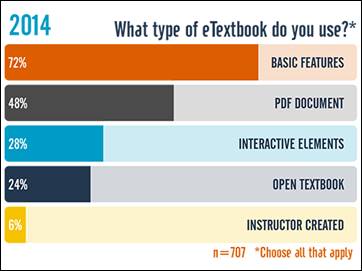




—————————–
Bossaller, J., & Kammer, J. (2014). Faculty Views on eTextbooks: A Narrative Study. College Teaching, 62(2), 68-75. doi:10.1080/87567555.2014.885877
http://login.libproxy.stcloudstate.edu/login?qurl=http%3a%2f%2fsearch.ebscohost.com%2flogin.aspx%3fdirect%3dtrue%26db%3dkeh%26AN%3d95094045%26site%3dehost-live%26scope%3dsite
Implementing eTexts into a Course:
- planning
- developing
- implementing
- delivering
This qualitative study gives insight into the experiences instructors have when working with publishers to integrate electronic content and technology into their courses.
Baek, E., & Monaghan, J. (2013). Journey to Textbook Affordability: An Investigation of Students’ Use of eTextbooks at Multiple Campuses. International Review Of Research In Open And Distance Learning, 14(3), 1-26.
http://eric.ed.gov/?id=EJ1017493
the Advisory Committee on Student Financial Assistance (2007) reported that textbook prices represent a significant barrier to students’ accessibility to textbooks. The report concluded that textbooks cost between $700-$1000 per year; textbook prices have risen much faster than other commodities; and that college aid fails to cover textbook expenses. Textbook costs are equivalent to 26% of tuition costs for an average four-year public university student and 72% of tuition costs for an average community college student. In fact, the California State Auditor (2008) reported that textbook costs grew more rapidly than student fees in academic year 2007–08.
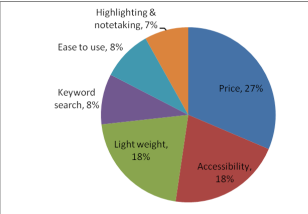
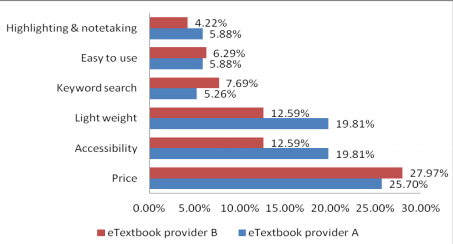
++++++++++++
Wimmer, E. e., Morrow, A. a., & Weber, A. a. (2014). Collaboration in eTextbook Publishing: A Case Study.Collaborative Librarianship, 6(2), 82-86.
http://login.libproxy.stcloudstate.edu/login?qurl=http%3a%2f%2fsearch.ebscohost.com%2flogin.aspx%3fdirect%3dtrue%26db%3dllf%26AN%3d108762075%26site%3dehost-live%26scope%3dsite
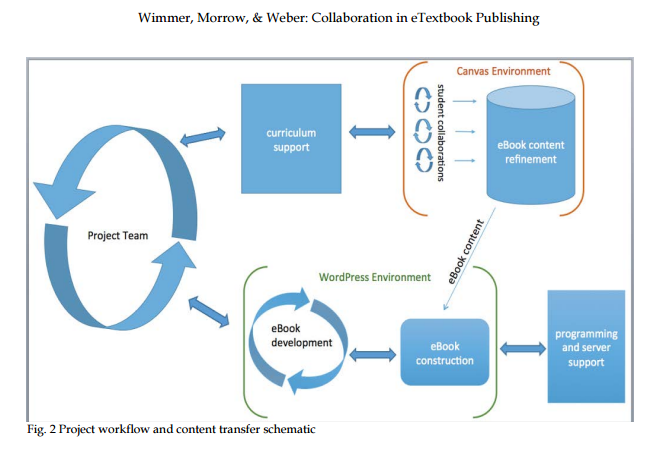
Distance education, e-learning, education and training. (2015). Clinical Chemistry & Laboratory Medicine, 53s557-s559. doi:10.1515/cclm-2015-5015
http://login.libproxy.stcloudstate.edu/login?qurl=http%3a%2f%2fsearch.ebscohost.com%2flogin.aspx%3fdirect%3dtrue%26db%3daph%26AN%3d102854748%26site%3dehost-live%26scope%3dsite
the creation of an interactive e-book called “Practical Clinical Chemistry: core concepts” was accomplished using the
Apple Macintosh platform and the iBooks Author software. Digital content, including videos, was developed for the
project and embedded within the final package. In order to limit the size of the final files, some content was uploaded
onto Youtube so that the user could access these via the internet.
The e-book, 200MB in size, was uploaded onto the Apple ITunes site and made available in 51 countries via the
iBooks store. This prototype is the first interactive digital textbook available in clinical chemistry and contains “4-
dimensional” content including digital images, videos, interactive presentations, real-time data generation as well as
review questions with instant feedback and assessment.
Hamedi, M., & Ezaleila, S. (2015). Digital Textbook Program in Malaysia: Lessons from South Korea. Publishing Research Quarterly, 31(4), 244-257. doi:10.1007/s12109-015-9425-4
Joseph, R. (2015). Higher Education Book Publishing-from Print to Digital: A Review of the Literature. Publishing Research Quarterly, 31(4), 264-274. doi:10.1007/s12109-015-9429-0
the author reflects the process on a state level (Ohio).
Marcoux, E. “. (2012). Best of the Best Planning. Teacher Librarian, 39(4), 69-70.
Taylor, A. K. (2011). Students Learn Equally Well From Digital as From Paperbound Texts. Teaching Of Psychology, 38(4), 278-281. doi:10.1177/0098628311421330
Much of the research related to digital texts has focused ontechnical aspects of readability (see Dillon, 1992, for a review) and limitations of digital media for note-taking, underlining, or highlighting text (Brown, 2001). However, the important—and unanswered—question from a teaching perspective is, ‘‘Can students learn as well from digital texts as from paperbound textbooks?’’ Few published studies have addressed this ques-tion directly, and even fewer studies have examined this ques-tion among college students.
Murray, M. C., & Pérez, J. (2011). E-Textbooks Are Coming: Are We Ready?. Issues In Informing Science & Information Technology, 849-60.
read the entire article, good data.
CourseSmart. FlatWorld Knowledge,
Horejsi, M. (2014). Textbooks 2.0. Science Teacher, 81(3), 8. http://login.libproxy.stcloudstate.edu/login?qurl=http%3a%2f%2fsearch.ebscohost.com%2flogin.aspx%3fdirect%3dtrue%26db%3daph%26AN%3d94603788%26site%3dehost-live%26scope%3dsite
++++++++++++++
pedagogy
two Eastern Europeans (Moldova, Serbia) raise serious concerns about electronic textbooks
Španović, S. (2010). PEDAGOGICAL ASPECTS OF E-TEXTBOOKS. Odgojne znanosti. 12(2). 459-470.
Railean, E. (2015). https://prezi.com/sbidiadctrzo/beyond-textbook-digital-textbook-use-and-development/
http://www.governance.ualberta.ca/en/GeneralFacultiesCouncil/CommitteeontheLearningEnvironm/~/media/Governance/Documents/GO05/LEA/15-16/WEB/Item-4-eTextbook-Subcommittee-Report-CLE-TLAT.pdf :
- (Un)desirable features in etextbooks
- How etextbooks might affect course delivery
- Pilot projects that can help build institutional expertise
- Address how and where insights gained from pilot projects will be collected and
- made available
- People resources (e.g., instructional designers) that will be needed to assist
- instructors to use this technology
ICWL (Conference) (13th : 2014 : Tallinn, E., & Cao, Y. (2014). New horizons in web based learning: ICWL 2014 international workshops, SPeL, PRASAE, IWMPL, OBIE, and KMEL, FET, Tallinn, Estonia, August 14-17, 2014, revised selected papers. Cham: Springer.
++++++++++++++++++++
MnSCU will by as Content Authoring Tool – SoftChalk. Here is a promo from Softchalk (my bold):
NEW SoftChalk Create 10 and SoftChalk Cloud eBook publishing features will arrive on April 25th! Come check out the latest enhancements at our upcoming webinars!
Sleek Designer Headers and Callout Boxes – Add some new pizazz to your SoftChalk lessons!
Three New Quiz Types – Test your students’ understanding with Sentence Completion, Multiple Blanks and Feedback Questions.
Polished New QuizPopper and Activity displays – With an enhanced interface for instructors and students.
Accessibility enhancements – Make your lessons available to everyone with even more accessibility enhancements.
NEW SoftChalk Cloud eBook creation and publishing – Includes a totally re-vamped, easier eBook creation and management. New SoftChalk eReader apps available for free download in the iOS, Android, Chromebook and Windows app stores. (Cloud Only)
+++++++++++++++++++++++++++
The future of textbooks looks like this
February 22nd, 2016
are any faculty really going digital? Which content distributors will thrive? What are the implementation concerns? And when will going digital really happen?
two massive surveys and reports by the National Association of College Stores (NACS) and the Independent College Bookstore Association (ICBA) in partnership with the Campus Computing Survey (CCS),
Universal Design for Libraries and Librarians
Instructors: Jessica Olin, Director of the Library, Robert H. Parker Library, Wesley College; and Holly Mabry, Digital Services Librarian, Gardner-Webb University
Offered: April 11 – May 27, 2016
A Moodle based web course with asynchronous weekly content lessons, tutorials, assignments, and groups discussion.
Register Online, page arranged by session date (login required)
Universal Design is the idea of designing products, places, and experiences to make them accessible to as broad a spectrum of people as possible, without requiring special modifications or adaptations. This course will present an overview of universal design as a historical movement, as a philosophy, and as an applicable set of tools. Students will learn about the diversity of experiences and capabilities that people have, including disabilities (e.g. physical, learning, cognitive, resulting from age and/or accident), cultural backgrounds, and other abilities. The class will also give students the opportunity to redesign specific products or environments to make them more universally accessible and usable.
Takeaways
By the end of this class, students will be able to…
- Articulate the ethical, philosophical, and practical aspects of Universal Design as a method and movement – both in general and as it relates to their specific work and life circumstances
- Demonstrate the specific pedagogical, ethical, and customer service benefits of using Universal Design principles to develop and recreate library spaces and services in order to make them more broadly accessible
- Integrate the ideals and practicalities of Universal Design into library spaces and services via a continuous critique and evaluation cycle
Here’s the Course Page
Jessica Olin is the Director of the Library, Robert H. Parker Library, Wesley College. Ms. Olin received her MLIS from Simmons College in 2003 and an MAEd, with a concentration in Adult Education, from Touro University International. Her first position in higher education was at Landmark College, a college that is specifically geared to meeting the unique needs of people with learning differences. While at Landmark, Ms. Olin learned about the ethical, theoretical, and practical aspects of universal design. She has since taught an undergraduate course for both the education and the entrepreneurship departments at Hiram College on the subject.
Holly Mabry received her MLIS from UNC-Greensboro in 2009. She is currently the Digital Services Librarian at Gardner-Webb University where she manages the university’s institutional repository, and teaches the library’s for-credit online research skills course. She also works for an international virtual reference service called Chatstaff. Since finishing her MLIS, she has done several presentations at local and national library conferences on implementing universal design in libraries with a focus on accessibility for patrons with disabilities.
Dates:
February 29 – March 31, 2016
Costs:
- LITA Member: $135
- ALA Member: $195
- Non-member: $260
Technical Requirements:
Moodle login info will be sent to registrants the week prior to the start date. The Moodle-developed course site will include weekly new content lessons and is composed of self-paced modules with facilitated interaction led by the instructor. Students regularly use the forum and chat room functions to facilitate their class participation. The course web site will be open for 1 week prior to the start date for students to have access to Moodle instructions and set their browser correctly. The course site will remain open for 90 days after the end date for students to refer back to course material.
Registration Information:
Register Online, page arranged by session date (login required)
OR
Mail or fax form to ALA Registration
OR
call 1-800-545-2433 and press 5
OR
email registration@ala.org
http://2016libtechconference.sched.org/event/69f9/come-on-down-gaming-in-the-flipped-classroom#

Instruction and Liaison Librarian, University of Northern Iowa
games and gamification. the semantics are important. using the right terms can be crucial in the next several years.
gamification for the enthusiasm. credit course with buffet. the pper-to-peer is very important
gaming types
affordability; east to use; speed to create.
assessment. if you want heavy duty, SPSS kind of assessment, use polldaddy or polleverywhere.
Kahoot only Youtube, does not allow to upload own video or use Kaltura AKA Medispace, text versus multimedia
Kahoot is replacing Voicethread at K12, use the wave
Kahoot allows to share the quizzes and surveys
Kahoot is not about assessment, it is not about drilling knowledge, it is about conversation starter. why do we read an article? there is no shame in wrong answer.
the carrot: when they reach the 1000 points, they can leave the class
Kahoot music can be turned off, how short, the answers are limited like in Twitter
Quizlet
screenshot their final score and reach 80%
gravity is hard, scatter start with. auditory output
drill game
Teach Challenge.
1st day is Kahoot, second day is Team challange and test
embed across the curriculum
gaming toolkit for campus
what to take home: have students facing students from differnt library
+++++++++++++
http://sched.co/69f2
Putting it all together: a holistic approach to utilizing your library’s user data for making informed web design decisions
In the age of Big Data, there is an abundance of free or cheap data sources available to libraries about their users’ behavior across the many components that make up their web presence. Data from vendors, data from Google Analytics or other third-party tracking software, and data from user testing are all things libraries have access to at little or no cost. However, just like many students can become overloaded when they do not know how to navigate the many information sources available to them, many libraries can become overloaded by the continuous stream of data pouring in from these sources. This session will aim to help librarians understand 1) what sorts of data their library already has (or easily could have) access to about how their users use their various web tools, 2) what that data can and cannot tell them, and 3) how to use the datasets they are collecting in a holistic manner to help them make design decisions. The presentation will feature examples from the presenters’ own experience of incorporating user data in decisions related to design the Bethel University Libraries’ web presence.
http://tinyurl.com/jbchapf
data tools: user testing, google analytics, click trakcer vendor data
- user testing, free, no visualization, cross-domain, easy to use, requires scripts
qualitative q/s : why people do what they do and how will users think about your content
3 versions: variables: options on book search and order/wording of the sections in the articles tab
Findings: big difference between tabs versus single-page. Lil difference btw single-page options. Take-aways it won’t tell how to fix the problem, how to be empathetic how the user is using the page
Like to do in the future: FAQ and Chat. Problem: low use. Question how to make it be used (see PPT details)
- Crazy Egg – Click Trackers. not a free tool, lowest tier, less $10/m.
see PPT for details>
interaction with the pates, clicks and scrollings
- scroll analytics
not easy to use, steep learning curve
“blob” GAnalytics recognize the three different domains that r clicked through as one.
- vendor data: springshare
chat and FAQ
Libguides
questions:
is there a dashboard tool that can combine all these tools?
optimal workshop: reframe, but it is more about qualitative data.
how long does it take to build this? about two years in general, but in the last 6 months focused.

